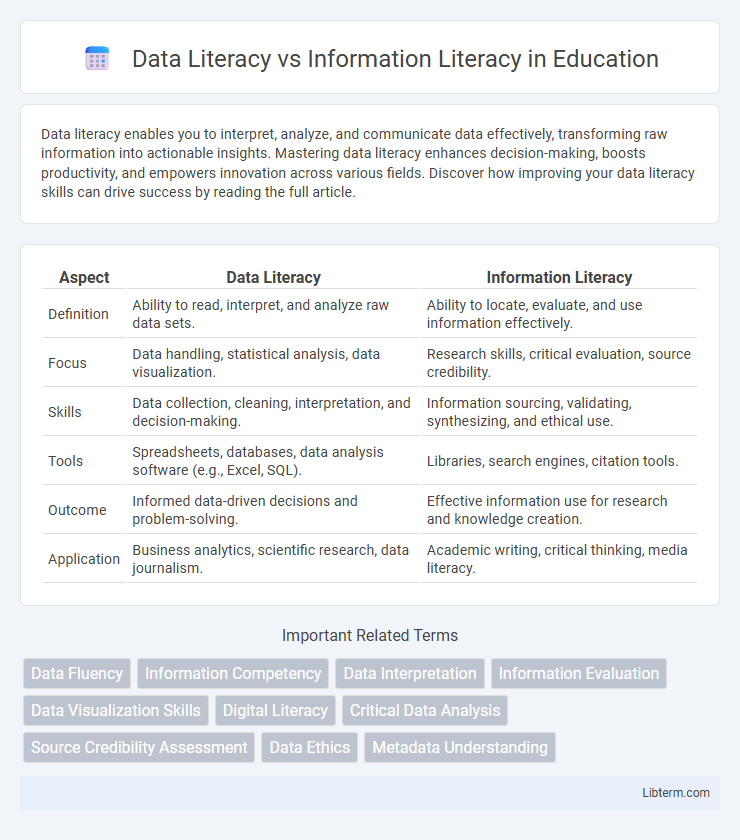Data literacy enables you to interpret, analyze, and communicate data effectively, transforming raw information into actionable insights. Mastering data literacy enhances decision-making, boosts productivity, and empowers innovation across various fields. Discover how improving your data literacy skills can drive success by reading the full article.
Table of Comparison
| Aspect | Data Literacy | Information Literacy |
|---|---|---|
| Definition | Ability to read, interpret, and analyze raw data sets. | Ability to locate, evaluate, and use information effectively. |
| Focus | Data handling, statistical analysis, data visualization. | Research skills, critical evaluation, source credibility. |
| Skills | Data collection, cleaning, interpretation, and decision-making. | Information sourcing, validating, synthesizing, and ethical use. |
| Tools | Spreadsheets, databases, data analysis software (e.g., Excel, SQL). | Libraries, search engines, citation tools. |
| Outcome | Informed data-driven decisions and problem-solving. | Effective information use for research and knowledge creation. |
| Application | Business analytics, scientific research, data journalism. | Academic writing, critical thinking, media literacy. |
Understanding Data Literacy: Definition and Scope
Data literacy entails the ability to read, interpret, and analyze raw data sets to make data-driven decisions across various contexts, emphasizing technical skills such as statistics and data visualization. Information literacy, by contrast, centers on recognizing when information is needed and effectively locating, evaluating, and using information from diverse sources, including digital and nondigital formats. Understanding data literacy involves grasping its scope, which includes data collection, data management, data ethics, and communication of data insights for practical application in business, science, and everyday life.
Defining Information Literacy: Key Concepts
Information literacy encompasses the ability to locate, evaluate, and effectively use information from diverse sources to solve problems and make informed decisions. Key concepts include critical thinking, source credibility assessment, and understanding the context and purpose of information. Mastery of information literacy empowers individuals to navigate digital environments, discern misinformation, and apply knowledge ethically.
Core Skills in Data Literacy
Data literacy core skills include the ability to collect, analyze, and interpret data accurately for informed decision-making, emphasizing numerical literacy, statistical reasoning, and data visualization. Proficiency in using data tools and understanding data sources, data quality, and ethical considerations distinguishes data literacy from information literacy, which focuses more broadly on evaluating and using information from various formats. Mastering data literacy requires critical thinking to transform raw data into meaningful insights, enabling effective problem-solving and strategic planning.
Essential Competencies of Information Literacy
Essential competencies of information literacy include the ability to identify, locate, evaluate, and effectively use information for specific purposes, emphasizing critical thinking and ethical use. Data literacy focuses more on understanding, interpreting, and analyzing data sets and statistical results to make data-driven decisions. Both literacies require skills in managing information but differ in scope, with information literacy encompassing broader sources and contexts beyond raw data.
Differences Between Data Literacy and Information Literacy
Data literacy involves the ability to read, understand, create, and communicate data as information, focusing on statistical analysis, data interpretation, and data-driven decision-making. Information literacy centers on recognizing when information is needed and the skills to locate, evaluate, and use information effectively from various sources, emphasizing critical thinking and source validation. The key difference lies in data literacy's focus on quantitative data handling and analytical skills, while information literacy encompasses broader skills related to qualitative information assessment and contextual understanding.
The Interrelationship of Data and Information Literacy
Data literacy and information literacy are inherently interconnected, as data literacy involves the ability to read, interpret, and critically evaluate raw data sets, while information literacy encompasses the skills to analyze, contextualize, and use information effectively. Mastery of data literacy enhances information literacy by enabling individuals to transform raw data into meaningful insights, facilitating informed decision-making and problem-solving. Understanding this interrelationship is critical for developing comprehensive digital literacy in an era driven by data-intensive technologies and information overload.
Why Data Literacy Matters in the Digital Age
Data literacy is crucial in the digital age because it empowers individuals to analyze, interpret, and make decisions based on complex datasets, driving informed business strategies and personal choices. Unlike information literacy, which focuses on evaluating the credibility of sources and understanding content, data literacy emphasizes proficiency in handling raw data, using statistical tools, and identifying patterns. Mastery of data literacy skills enhances problem-solving capabilities and fosters a data-driven culture essential for navigating the vast amounts of information generated daily.
The Role of Information Literacy in Critical Thinking
Information literacy plays a pivotal role in enhancing critical thinking by enabling individuals to evaluate the credibility, relevance, and bias of various information sources. Mastery of information literacy skills ensures users can effectively discern fact from opinion, recognize misinformation, and make informed decisions based on evidence. This competency is essential for navigating complex digital environments and fostering analytical problem-solving abilities essential in academic, professional, and everyday contexts.
Integrating Data and Information Literacy in Education
Integrating data literacy and information literacy in education enhances students' ability to critically analyze and interpret complex datasets alongside evaluating the credibility and relevance of information sources. Combining skills such as data analysis, visualization, source evaluation, and contextual interpretation prepares learners for evidence-based decision-making in academic and professional environments. Educational curricula that embed both literacies promote digital competence, critical thinking, and lifelong learning essential for navigating the information-rich digital age.
Building a Literate Society: Challenges and Solutions
Building a literate society requires overcoming challenges such as unequal access to technology and inconsistent education standards in both data literacy and information literacy. Implementing targeted training programs and promoting critical thinking skills can enhance individuals' ability to interpret, analyze, and communicate data effectively. Collaboration between educational institutions, governments, and private sectors is essential to create comprehensive curricula that bridge gaps and foster lifelong learning.
Data Literacy Infographic

 libterm.com
libterm.com